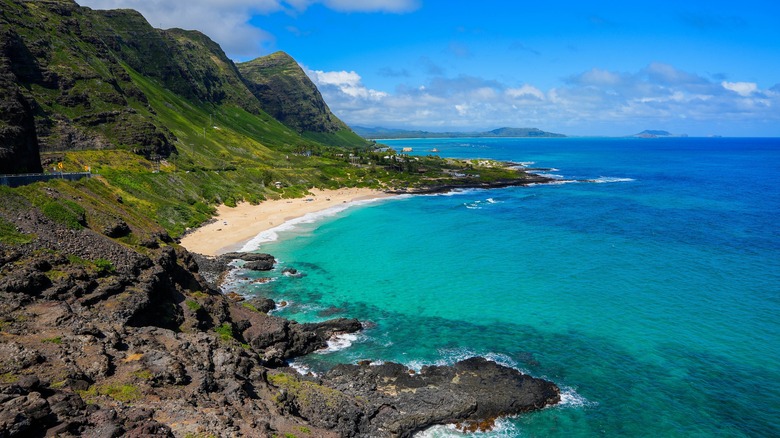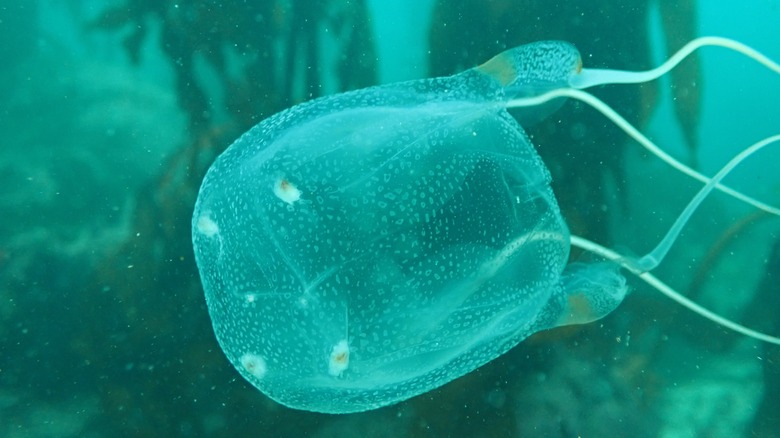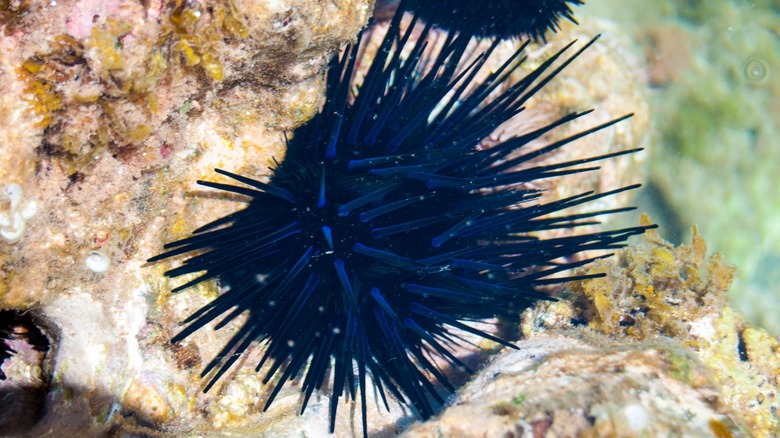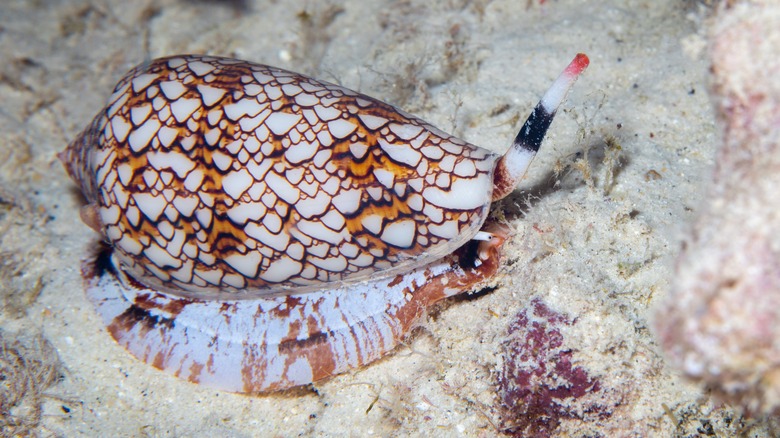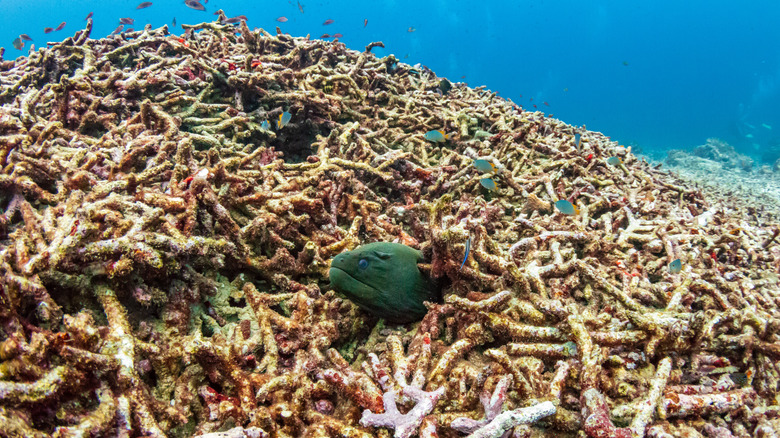5 Creatures To Beware Of When Swimming In The Hawaiian Waters
There are many reasons why Hawaii and its idyllic islands are some of the best places to travel in the U.S. Besides the breathtaking beaches and clear waters, Hawaii also contains a bucket-list-worthy national park and some of the most beautiful campgrounds in the United States. However, a lot of travelers don't know that this tropical paradise is more dangerous than they realize. Hawaii's beaches are famous for strong currents and huge waves (two of Hawaii's beaches ranked as some of the most dangerous places to surf). However, you don't have to be a surfer to get injured in the waters of Hawaii.
Even for swimmers and snorkelers, it is easy to underestimate the strength of the waves and not consider what types of dangerous animals may be lurking inside. The ocean surrounding Hawaii is teeming with life and, although most ocean creatures in the clear waters of the Aloha State are harmless, some can cause injury and even death. Because of this, the Hawaii Department of Land and Natural Resources (DLNR) warns that all visitors should treat stepping into the islands' waters like entering a nature reserve where you are simply a visitor in the habitat of wild animals. So, while you are visiting the bright blue oceans of Hawaii, here are some dangerous creatures to look out for.
Box Jellyfish
Box jellyfish are one of the most dangerous types of jellyfish in the Pacific Ocean. The reason for this is that, unlike most jellyfish, box jellyfish can see and can also swim after prey instead of simply floating on the surface of the water with the currents like most jellies. On top of this, box jellies deliver a painful sting from long-reaching tentacles that are covered in tiny barbs loaded with poison. While certain types of box jellyfish can be deadly, the good news is that the species of box jellyfish that is typically found near Hawaii typically isn't. However, the sting of a Hawaiian box jelly is still extremely painful (more so than that of a Portuguese Man of War) and may require medical attention.
Luckily, the local authorities of Hawaii often track and predict when these jellyfish are numerous and close to shore. In general, box jellyfish are more common on south shore beaches and the island of O'ahu from April to September. However, the Waikiki Aquarium warns that jellyfish can be in Hawaii's waters any time of year and that swimmers should always be careful. Therefore, when in Hawaii, make sure to pay attention to all beach warning signs and advisories and avoid the water when there is a high concentration of box jellyfish.
Sharks
Like any beach vacation destination, Hawaii experiences its fair share of shark attacks. In fact, according to SFGate, on average there are around seven or eight shark attacks in Hawaii every year. While this may sound frightening, your likelihood of being bitten by a shark is quite low (especially considering the sheer number of people who swim, snorkel, and surf in Hawaii's waters). However, attacks do happen and the culprit behind them is probably not who you think. In Hawaii, it's not Great White Sharks you need to look out for (they are quite rare around the islands) but rather tiger sharks.
In fact, tiger sharks are known as the most aggressive species of shark in the oceans of Hawaii and are responsible for the most attacks followed by the Galapagos shark. The reason for this is that female tiger sharks — which are often larger than the males — are drawn to the reef habitats common in the waters around the islands, particularly the island of Maui. This is why Maui experiences double the number of shark attacks of any other Hawaiian island with most incidences typically occurring from October through December during the tiger shark mating season and when the island has a large number of migratory whales.
Long-spined venomous sea urchin
Although long-spined venomous sea urchins (called wana in Hawaiian) don't have enough venom to kill you, encountering one of these spiky balls of pain can ruin your week. This is because sea urchins are common in the Hawaiian Islands and are easy to accidentally step on if you are not paying attention to where you are placing your feet. Once you step on a wana (or accidentally kick one) you are sure to get some of its spines embedded in your foot which will cause a sharp burning pain. While the initial pain should lessen after 15 minutes, the aching pain can stick around until the urchin spines eventually dissolve in your foot.
Once stung, you can try to remove the protruding urchin spines. However, these spines are often quite brittle and many of them will simply break off and stay in your foot. It is often recommended to soak the stung area in warm water and vinegar to more quickly dissolve the venomous spines thereby reducing the pain. However, in all likelihood, the pain will last anywhere from three to seven days.
Cone snail
Another small ocean critter you need to look out for is the cone snail. These aquatic snails are prized for their beautiful spiral-shaped shells. However, when in Hawaii, you should never pick up a cone shell, even if you think it's empty, because it could be hiding a toxic secret. Cone snails often hide deep inside their shells and have a venomous stinger that they use to incapacitate their prey. There are 34 different species of cone snails living in the waters around Hawaii and the toxicity of their venom ranges from simply painful to life-threatening.
Of all the cone snails, the fish-eating varieties are the most dangerous and can deliver a dose of venom strong enough to cause paralysis and death. In Hawaii, the most deadly species are the striated and textile cone snails. It is quite unlikely that either of these snails will crawl up to a person and sting them, but the risk comes when snorkelers or divers touch a cone snail thinking it's simply a pretty shell, and receive a defensive sting. Cone snail stings are powerful and sharp enough to go through gloves and dive suits. Unfortunately, there is currently no antidote for cone snail venom.
Moray eel
The last frightening creature you should be aware of while swimming in Hawaii is the moray eel. Moray eels typically live in the crevices of rocks on the ocean floor and are unlikely to attack humans unless they feel their den is under threat. However, once provoked, a moray eel can deliver a bite that can remove fingers and toes or even take off chunks of flesh. While eel bites are not poisonous, the mouths of these creatures may contain certain toxins that can easily cause infection and require medical treatment with antibiotics.
Eels also have extremely sharp teeth, so much so that their bites are sometimes confused for shark attacks. According to Honolulu Civil Beat, this is what happened to one surfer who was in the water off the coast of Waikiki when something attacked his foot. The victim was then hospitalized with emergency responders first reporting the event as a shark attack before it was later confirmed to be the bite pattern of a moray eel. Although eel bites are uncommon, these long mucous-covered fish are extremely quick and can deliver a painful blow in a matter of seconds. Moray eels also have a second jaw (like a xenomorph from the "Alien" movies) that can come out for a second bite.
